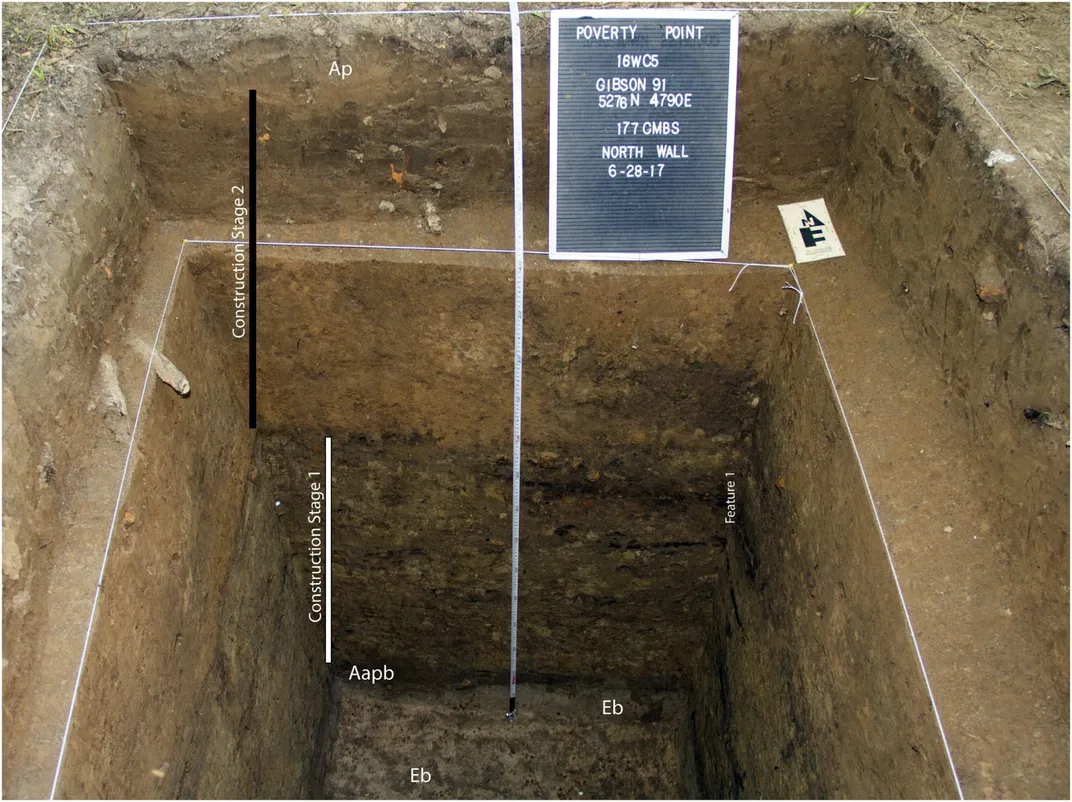Louisiana’s Poverty Point Earthworks Show Early Native Americans Were ‘Incredible Engineers’
A new study finds that enormous mounds and concentric earthen ridges were built in a matter of months
/https://tf-cmsv2-smithsonianmag-media.s3.amazonaws.com/filer/99/bb/99bb6d6d-6884-4f44-bfa9-776b84380556/earthworks.jpg)
New research shows that people who lived in what’s now north Louisiana around 3,400 years ago had sophisticated engineering expertise, David Nield reports for Science Alert. The remains of earthen mounds built by the mysterious civilization still rise as much as 66 feet above the ground at Poverty Point, Louisiana. The new study, published in the journal Southeastern Archaeology, finds that people of the region raised the enormous earthworks in a matter of months or even just weeks.
“One of the most remarkable things is that these earthworks have held together for more than 3,000 years with no failure or major erosion,” study author Tristram R. Kidder, an anthropologist at the University of Washington in St. Louis, says in a statement. “By comparison, modern bridges, highways and dams fail with amazing regularity because building things out of dirt is more complicated than you would think. They really were incredible engineers with very sophisticated technical knowledge.”
Even in the face of frequent, heavy rainfall, the mounds have apparently held together for so long thanks to this knowledge. Using microscopic analysis of the soils that make up the mounds, the new study shows that builders mixed different types of clays, silts and sand to make the construction more durable.
“Similar to the Roman concrete or rammed earth in China, Native Americans discovered sophisticated ways of mixing different types of materials to make them virtually indestructible, despite not being compacted,” Kidder says in the statement. “There’s some magic there that our modern engineers have not been able to figure out yet.”
The researchers determined the rapid pace of construction using radiocarbon dating and magnetic measurements of soils. They found no evidence that rain or wind weathered the materials between stages of construction, suggesting that there were no significant pauses in the process.

“Between the speed of the excavation and construction, and the quantity of earth being moved, these data show us native people coming to the site and working in concert,” Kidder says in the statement. “This in and of itself is remarkable because hunter-gatherers aren’t supposed to be able to do these activities.”
Even more remarkably, the mounds’ builders did their completed the structures without work animals or wheeled carts, the New York Post’s Hannah Sparks reports.
Monumental Earthworks of Poverty Point became a Unesco World Heritage site in 2014. The 400-acre site holds five mounds and six C-shaped concentric ridges. Unesco notes that one exceptional aspect of the site is that it was built by people who supported themselves by hunting, gathering and fishing. In contrast, many later monuments were made by people living in farming economies. Researchers suspect the site was a center of religious activity for the region, as well as a home to some people.
According to the Poverty Point World Heritage Site tourism website, the site was at the center of an expansive trade network that brought tons of rocks and minerals from as far as 800 miles away. In a place with few rocks nearby, locals used imported stone to craft weapons and tools. Artifacts found at the site included owls carved from red jasper stone and ceramic human figurines. Local people lived in houses built with wooden posts and a woven framework of sticks covered in mud. Unlike in many parts of North America, the mounds were not burial sites or trash heaps and instead may have been designed to showcase the wealth and power of the people who made them.
The site was abandoned abruptly between 3,000 and 3,200 years ago, probably due to flooding in the Mississippi Valley. While other people later occupied part of the site around 700 A.D., it remained mostly abandoned until the 19th century.
/https://tf-cmsv2-smithsonianmag-media.s3.amazonaws.com/accounts/headshot/Livia_lg_thumbnail.png)
/https://tf-cmsv2-smithsonianmag-media.s3.amazonaws.com/accounts/headshot/Livia_lg_thumbnail.png)